Saving the Deep Blue Yonder
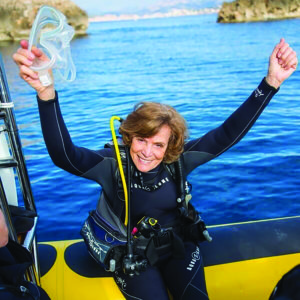 Photo by Stuart Pearce
Photo by Stuart Pearce DR. SYLVIA A. EARLE is explorer in residence at the National Geographic Society, the founder of the Sylvia Earle Alliance (S.E.A.) / Mission Blue and the founder of Deep Ocean Exploration and Research Inc. (DOER). She chairs the advisory council for the Harte Research Institute and is a former chief scientist for the National Oceanic and Atmospheric Administration (NOAA). Earle is the author of more than 200 publications and leader of more than 100 expeditions with over 7,000 hours underwater. Her research concerns the ecology and conservation of marine ecosystems and development of technology for access to the deep sea. She has received more than 100 national and international honors and awards, including being named Time magazine’s first Hero for the Planet, a Living Legend by the Library of Congress, 2014 UNEP Champion of the Earth, and Glamour magazine’s 2014 Woman of the Year. She is the recipient of the 2009 TED Prize, the Walter Cronkite Award, the 1996 Explorers Club Medal, the Royal Geographic Society 2011 Patron’s Medal, and the National Geographic 2013 Hubbard Medal. On June 10, 2017, Earle was awarded the Isaac Asimov Science Award at the 76th Annual Conference of the American Humanist Association. The following has been adapted from her remarks in acceptance of the award.
Thank you. I’m grateful for the opportunity to be among kindred spirits. I haven’t known much about the American Humanist Association, but I do feel as if I’m at home. What can I say? I never worried too much about whether I would behave in such a way that I might go to heaven or the other direction. Because for me, heaven is right here on earth, especially in the ocean.
I once was privileged to have lunch with Clare Boothe Luce, who was a US Representative (R-CT), US ambassador to Italy and Brazil, a playwright, and all-around good human being, I think. The question that we were deliberating over luncheon in her home in Hawaii was: Why is it that so much attention is given to the skies above while the ocean is largely ignored? Why are we investing billions of dollars to advance our access not just to our own atmosphere but over the moon and Mars and the sky literally without limit? “I think it’s really simple,” she said. “Heaven is up there in that direction. You know what’s in the other.”
Now, we know that we’re all literally made of stardust. Why is it a beautiful thing to know where we come from? It tells us something about who we are and maybe even gives us a better idea of how to shape a future that’s good for us. We’re the only animals who really have that kind of choice. There are other intelligent animals: elephants are really smart and so are dolphins, whales, cats, dogs, and horses. Many of them have a sense of humor, it seems, not just humans. But they don’t know why the world is changing. They can’t answer questions such as what stars are. I can imagine dolphins looking up from their place in the sea, wondering. When they dive down, they see the visual equivalent of stars, the bioluminescent organisms almost like comets, moons, and suns there in the depths of the sea.
I love the idea that someday we actually will put footprints on Mars, maybe even set up housekeeping there, but not for all seven billion of us or ten billion or however many we get to be eventually. It’s curious that we’re so focused on trying to terraform Mars at the same time we are really Mars-forming Earth. It is almost as if aliens have commanded us to do everything possible to unravel four and a half billion years of fine-tuning to consume the natural world in such a way that we’ll do ourselves in. Then the microbes will take over.
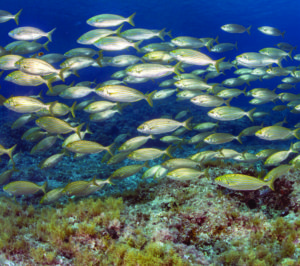
Photo by Kip Evans | Mission Blue
Children today are witnessing not only unprecedented new discoveries about the nature of nature, about who we are, and about how we might get to a better place; they’re also witnessing news and headlines everywhere about the decline of human society, about the decline of the ocean, about the atmosphere and climate change. Good reasons to be depressed—woe is me. What is their future going to be? Fortunately, we’ve had those pioneers who come back from high in the sky and tell us what they’ve seen.
When I was first a witness to the exploration of space, there were all guys up there, of course. In 1969, when footprints were being left on the moon, a program came into existence to go in the other direction with aquanauts. Again, though nobody bothered to say this is just for men, some of us thought going into the depths as an aquanaut and living underwater for weeks at a time sounded like a really cool idea. Scientists and engineers, men and women applied. It really was owing to the director of the program, Dr. James Miller, who I think had a good relationship with his mom. I think he had a good marriage. Because when the question was posed to him about what they should do when applications from women came across his desk, he had to decide should there or should there not be women participating in this experiment, the equivalent of a space station under the sea. Legend has it that he said, “Well, half the fish are female. I guess we could put up with a few women.”
So, five of us were selected. I was asked to be the leader of the team, probably because I had more time under the sea than the other applicants, who were a bit younger than me. Still, the idea of men and women living together underwater was pretty radical in 1970. They even warned us there could be hanky-panky on the reef. Well, times have changed. Women astronauts, even commanders of the spacecraft, go high in the sky. Men and women together have spent days and weeks under the sea living in space equivalents in various parts of the planet. What remains today is the Aquarius underwater lab in the Florida Keys.
My parents and past generations simply couldn’t imagine the ease with which people can now dive in places where no one had convenient access before—in the Arctic, in Antarctica, with scuba tanks or with rebreathers that allow you to recycle air and stay underwater for long periods of time. And with little submarines, you’re not just limited to where compressed air and scuba can take you. It’s like the early days of aviation with little craft that you can get into and fly underwater. (Some of these are so simple to drive even a scientist can do it!)
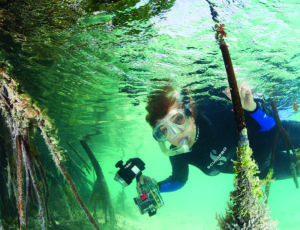
Sylvia Earle diving among mangroves. (Photo by Kip Evans | Mission Blue)
We actually dreamed up a series of expeditions that involved kids and teachers as well as scientists to look at the coastal waters of this country. Yes, by diving; yes, by stomping through marshes; and yes, also using little subs to go down to a thousand, two thousand, three thousand feet beneath the surface. Involving the kids is such fun. We even jammed a passenger sub in Hawaii with kids and teachers and then danced around them in two little submarines.
In Hawaii in 1979 I went down 381 meters. I had the chance to observe corals that were like big spirals, like big whiskers without branches coming up from the sea floor like a forest, a field of them. When you touch them, they just burst with bioluminescence. I really loved that experience. But I didn’t love not being able to share it with others because the cameras at the time could take pictures of the corals, but not of the bioluminescence.
This past summer, however, I was able to engage the Pisces submarines at the University of Hawaii. They go to 2,000 meters, take three people in each sub, and as was done during the expedition with the National Geographic Sustainable Seas, we took teenagers along. They came from Washington, DC, and some had never seen the ocean before. Some had never been on an airplane. They certainly had never been diving with sharks or dolphins or traveled in a submarine.
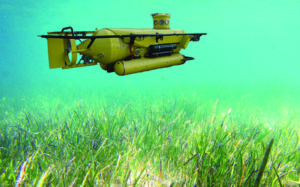
Photo by Danilo Mongiello | Dreamstime
We went back to the same place where I saw the coral in 1979. This time I was able to share it with the kids to give them a glimpse of what it’s like to be down in the twilight zone where sunlight meets darkness at about a thousand feet beneath the surface, and to go through that stage of looking at pale blue turning to medium blue. It just gets darker and deeper, and finally it’s black. But it’s also illuminated: 90 percent of the organisms that live in the deep sea have some form of bioluminescence. I’m able to share it now because technology has made it possible with cameras that shoot at four million ISO, literally take pictures in the dark.
I think all things considered, one of the best investments, maybe the best investment that any of us can make, is what people have been doing throughout the history of humankind. You learn something. You pass it along. You learn something else. You pass it along. Over the ages, we got the alphabet. We got numbers. We have knowledge. Passing the information along to kids is the best hope we have that the next generation will be able to have a better world than we have experienced.
But now, we’re seeing a degradation of the planet that was really gifted by four and a half billion years of fine-tuning long before there were humans. Humans are literally changing the nature of nature. We can see it with clearcut forests. We can see it with the atmosphere. What’s largely missing from the equation is what’s going on beneath the surface, because at the surface, it looks pretty much the way it always has.
I went to the Gulf of Mexico last summer as well, and I was able to do some exploration there in a submarine that I had a hand in building back in the 1980s. I love the idea that it’s rugged and reliable and still operating. James Cameron is a fellow explorer-in-residence at National Geographic, and while most people think of him as a filmmaker, he’s many things—an artist, a scientist, an engineer. He says he makes films so he can make submarines. He built one that took eight years and then in 2012 he went, by himself, to the deepest part of the ocean in. The really important part is that he came back.
When I began diving, I was told to watch out for the “man-eaters,” the things with big teeth, not just sharks but crocodiles. I joked that I didn’t have to worry about man-eaters because I don’t qualify. As we later learned—and it took some time—we’re not on the menu of these animals, not sharks or the giant groupers or the other things we imagined were out there to get us when we went into the ocean. But we’re eating a lot of them.
Things that I worry about now with big teeth in the ocean are devices, like deep-sea mining equipment, that are really taking hold. It was an idea that got some traction in the 1970s and ’80s. Then they started crunching the numbers and realized that the cost of getting to the deep sea to extract manganese nodules, later looking at the hydrothermal vents and the mineral-laden crust that are associated with some of the deep sea formations, just wasn’t cost-effective. But now, it’s beginning to be cost-effective, or at least it seems so, especially with big subsidies to power these magnificent industrial ambitions.
But where are the billions of dollars to explore the ocean, to at least take a look at what’s happening in the deepest part of it? We should know what we’re doing instead of just ripping through whatever’s on the bottom of the ocean with giant machines. It’s like clearcutting rainforest before you’ve had a chance to figure out who’s living there and what their real value may be.
We need to invest in technologies to take us there. I mean any of us. Do you know there are only three people in the history of the planet who’ve been seven miles down? How many of you have not been seven miles up? Isaac Asimov was one of those who didn’t like to fly, which is curious given all his wonderful writings and imagination and stories about what it was like in space. He loved to be on solid ground. But most people do like the idea of being able to get in an aircraft and fly. Why don’t we have a similar passion for getting into a little submarine? I personally think there’s nothing quite like it.
Now, we know that there are beings whose lives are tied to ours who are being affected by what we do or what we fail to do. We used to value whales as pounds of meat, barrels of oil. Now, we see other values. Because we took action in the 1980s, and are still taking action to restore whales to some form of abundance (more than what existed when I was a kid), we don’t have to just see whales in museums. But we’re right on the edge of extinction with not just dozens, not just hundreds, but thousands of living things, some more notable, more obvious than others.
There’s a little dolphin that lives in the Gulf of California called the vaquita. Just recently, a survey found there are only thirty remaining, not because people were targeting them to eat or for pets or because they don’t like them for some reason. It’s because vaquitas get caught in the same nets as a fish called the totoaba, for which there’s a well-established Chinese market (the totoaba’s swim bladders are considered a delicacy with possible medicinal value). It’s marketing of wildlife that has really put so many creatures at risk on the planet. It wasn’t necessarily marketing that did in the dodo many years ago. But it was humankind consuming our neighbors.
In 1991, when I was chief scientist at NOAA, a little piece of paper came across my desk that said that in the North Atlantic, only 10 percent of the tuna remained from 1970 levels. I thought, wow, in twenty years humans have exerted their power to take a population of fish who have never known predations except from maybe orcas or a few sharks down by 90 percent. At a fisheries meeting I asked, what are we trying to do, exterminate them? Today, the Pacific bluefin tuna are down to about 5 percent if you’re generous with your numbers.
We could be the last people on the planet in the next ten years or so. Maybe with enough flexibility in the population of these fish, they can stick around for twenty or thirty years. But at the rate of loss, even with attempts to keep them around with limits on catch and all that, it’s just hard to imagine that they can recover to something like their abundance before marketing tuna for tuna fish sandwiches and sushi or sharks for shark fin soup. Even the biggest fish in the sea, the great whale shark, is at risk.
There’s another factor along with taking so many fish from the sea in such a short period of time. We thought the ocean was the best place to put things we didn’t need or want next to where we live. So it’s been flowing into the sea probably for as long as humans have been around. But we’ve created more trash, especially plastics, since the middle of the twentieth century than during all preceding history.
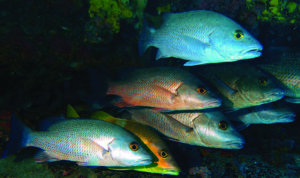
Photo by Sylvia Earle
It’s estimated that by the middle of the century, there may be more plastic in the ocean than fish. It’s a really big thought that we’re reducing the amount of fish and we’re increasing the amount of junk. It’s affecting things. It’s not just about fish and the whales and organisms that live in the sea because we’re all from the sea when you think about it. We all need the ocean. If you live on earth, you need water, but you also need oxygen. We need the carbon sink; we need it for the chemistry of the planet to work in our favor. That’s largely driven by the little guys, organisms that generate oxygen, take up carbon dioxide, and pass the energy along to zooplankton that, in turn, pass energy along to the small fish and the little crustaceans and the larval cross-section of life on earth. Starfish and sponges and a lot of things have their young stages floating around in the ocean. They get eaten along the way. Taking a picture of this lively food chain in action is evidence of how chemistry of the ocean is shaped by life in the ocean. You just have to remember while you’re observing a food chain in action in the sea not to become part of it.
Having spent thousands of hours underwater, lived underwater now ten times and used more than thirty kinds of submarines, I’ve really gotten to see fish with new eyes, see them as living things. Like cats and dogs and horses, they have faces. They have homes. They have personalities. Getting to know them changes your way of thinking about them, like when you eat a fish, it’s not just some thing. It’s someone, somebody. Some fish, like some humans, mate for life. They’re all curious; we’re not unique in that respect. What we see now—unprecedented change coupled with unprecedented knowledge—gives us a fighting chance to restore once-vibrant reefs that now look like piles of rubble.
It was George W. Bush who established what, at that time, was the largest marine-protected area on the planet, the Papahānaumokuākea Marine Reserve in Hawaii. Bush was noted, generally, for his conservation ethic, but maybe it was the shock of seeing him do something so bold for the ocean that other nations began taking notice. China has established a number of protected areas around their coastline—and at the same time they’re doing some dastardly things to the ocean, extracting fish on a scale larger than most other nations.
Nations around the world, including ours, have extended jurisdiction out 200 miles starting in the 1980s. The fish don’t know this. The plankton don’t know that there are borders out there in the ocean. What’s interesting is that we have the authority in this country. A little island nation such as Palau and Kiribati in the Cook Islands, and Aldabra that’s a part of the Seychelles, they actually are small bits of land in a big ocean. Some of these little bits of land have a big claim on the ocean. Some are exerting that claim so that Palau has boldly protected 80 percent of their entire exclusive economic zone. Imagine if every country around the world with a coastline said, look, it’s got a precautionary principle. It’s like keeping things in the bank. It’s not extracting everything that’s out there.
Right now, only about 3 percent of the ocean is actively protected. The rest of it is up for grabs. Although there are rules and regulations, what is the consequence of taking populations of fish from where they were in the 1950s to unprecedented lows? I mean really, it’s hard to find a healthy population of any kind of marine animal today owing to our appetite for their products, and of course for munching on them. Bush, when he took his action, created the largest protected area in the world. Right now, it’s number twelve. Because of actions the UK, South Africa, and Peru have taken, new blue parks have been formed.
It was President Barack Obama who quadrupled the size of the Papahānaumokuākea Marine Reserve and established the first marine reserve out in the North Atlantic Ocean. Just a few weeks after that, an even larger place was established around the waters of Antarctica. Think about it. Who owns the waters around Antarctica? Who owns Antarctica? I mean if anybody does, we all do, part of the global commons. The land is protected, but the ocean is not. There are no safeguards for protecting where these deep-sea fish live—Chilean sea bass, otherwise known as Patagonian toothfish, and orange roughy.
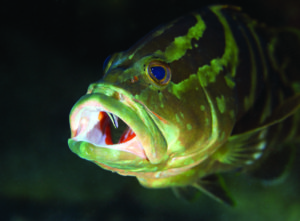
Photo by Kip Evans
When I appeared on the Colbert Report in 2009, Stephen Colbert said, “What about fish? We give them these fancy names so people will eat them.” I said, “Yes, orange roughy are known to scientists as slimeheads. If we marketed them as that, they probably wouldn’t be too popular.” He joked, “Well, maybe we should start marketing earthworms as Appalachian yard trout. Perhaps, people would go for them.”
I don’t know what it’s going to take to inspire people to care about the ocean. This area in Antarctica finally was set aside, the largest marine-protected area so far. Still, as I said we have only 3 percent of the sea that has some form of active protection.
In recent years I’ve been trying to identify critical areas in the ocean that are still in pretty good shape, those places that have been depleted or see the decline but that can be restored. Whether you do it by actively naming places like Yellowstone Park or the Great Barrier Reef or simply designating a place in the ocean as a hope spot, you can enlist people to say what they’re going to do and how they’re going to act to increase protection for the world.
In 2012 I had a chance to meet a bird who lives in Midway Island in the middle of Papahānaumokuākea Marine Reserve. She began to fly at about the same time I began learning to dive in the 1950s. I had to sit and pay my respects because that bird is a survivor and so was the chick she was about to hatch, which was named Hope by the people who’ve watched her mother for many years. She’s been over thousands of miles of ocean. She goes out there every year looking for food. She’s finding it harder because there are fewer squid, fewer fish, and a lot more plastic out there in the broad Pacific where she travels.
I know why those changes are happening. I know that we can do something about it. We can shape the future. Protect the natural systems that make it possible for us to exist in this little blue speck in the universe.
I thank you for this award and for giving me a chance to share some sea stories. I look forward to a time when I can see you again, maybe underwater in a little submarine.
